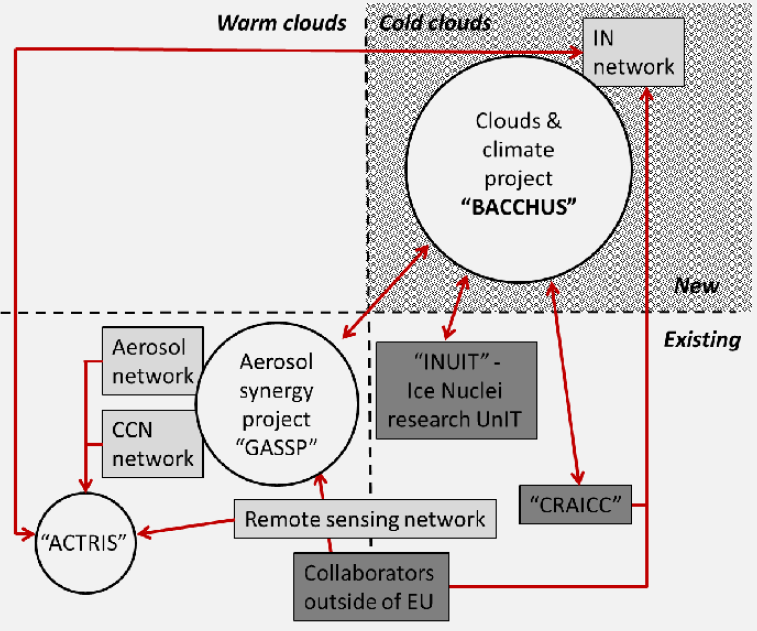Workpackage 1
Collection and harmonization of aerosol, CCN, IN and cloud properties datasets
Leader: Albert Ansmann (Leibniz Institute for Tropospheric Research, Germany), Cristina Facchini (National Research Council, Italy)

WP1 will collect and harmonize long-term observations, field and laboratory
studies of the physical and chemical properties of aerosols particles, CCN and
IN. WP1 will develop a strategy to make use and to incorporate this data into
existing European networks and synthesis projects such as the Global Aerosol
Synthesis and Science Project (![]() GASSP,
see
GASSP,
see ![]() figure above). Combining this data with in-situ and remote measurements of warm and ice-containing clouds and aerosols, WP1 will provide the best estimate of the natural (pre-industrial) background aerosol, and discriminate anthropogenic and biogenic contributions to the CCN/IN aerosol fractions. WP1 will compile aerosol/cloud data sets for key contrasting environments and provide the basis for comprehensive modelling efforts (WP2, parameterisations, WP3, cloud process modelling, and WP4, climate modelling). These objectives are split into six tasks.
figure above). Combining this data with in-situ and remote measurements of warm and ice-containing clouds and aerosols, WP1 will provide the best estimate of the natural (pre-industrial) background aerosol, and discriminate anthropogenic and biogenic contributions to the CCN/IN aerosol fractions. WP1 will compile aerosol/cloud data sets for key contrasting environments and provide the basis for comprehensive modelling efforts (WP2, parameterisations, WP3, cloud process modelling, and WP4, climate modelling). These objectives are split into six tasks.
This task will compile the concentration and chemical and physical properties of the natural background aerosol in different key regions. It will determine if and how these background aerosol levels can be used as a proxy for pre-industrial conditions. This will lay the basis for the anthropogenic aerosol effect estimates using ESMs (WP4) and will contribute to/interact with tasks 1.3, 1.4 and WP2. Additionally, the measurement framework for the IN database will be elaborated, taking into account the different atmospheric freezing mechanisms, environmental conditions and existing IN measurement technology, enabling task 1.6.
This task will include new measurements taken during the BACCHUS lifetime to compile the geographic differences in IN and CCN between locations such as the Arctic, Northern European boreal forest, mid-latitude Atlantic, tropics, north, central Europe, Mediterranean and the Amazon forest. IN properties to be measured include the IN number concentration, the IN activated fraction at certain temperatures and relative humidity and if possible the IN chemistry. CCN properties will be measured, analysed and handled according to already existing data protocols.
This task aims to quantify the contributions to IN concentrations by natural biogenic (fungal spores, bacteria, pollen, sea-spray gels, marine bacteria and viruses) and dust particles versus that of anthropogenic aerosols. It will focus on chemical characterization, contrasting biogenic versus anthropogenic environments with short-term comprehensive measurements. Primary biological particles will be compiled with on-line measurements. It will use measurements from the Amazon rain forest, boreal coniferous forests, urban and rural sites in Europe and India, Cyprus and Crete.
This task will quantify the biogenic and anthropogenic contribution to the organic aerosol (possibly distinguishing between primary and secondary organic particles, POA and SOA) and their ability to act as CCN. Field experiments in contrasting environments (polluted vs. clean air masses, different remote environments) and laboratory studies will be integrated by using statistical tools (e.g. positive matrix factorization analysis) to define the chemical fingerprints of the different aerosol types: sea spray, anthropogenic SOA, biogenic SOA, biomass burning particles and fossil fuel combustion particles. The main processes in organic aerosol-cloud interaction, including ageing mechanisms, will be addressed by integrating the results of old and new experiments carried out in the Po Valley, Italy.
This task will obtain the vertical structure of aerosol and clouds through in-situ, active (lidar, radar) and passive (satellite) remote sensing measurements of aerosols, clouds and aerosol-cloud interaction and vertical profiling of aerosols and clouds with aircraft and UAS. This will allow for closure/satellite validation studies and the integration of field observations. The influence of aerosol versus meteorological factors on cloud formation will be contrasted, with an emphasis on heterogeneous ice formation. Algorithms will be developed for the simultaneous retrieval of aerosol and cloud properties. The validated satellite-retrieved aerosol and cloud properties, precipitation forming processes and CCN in the cloudy boundary layer will be applied to pristine and perturbed conditions to constrain regional simulations and the parameterisations used by ESMs in WP4.
This task is based on all foregoing tasks 1.1-1.5. An aerosol/cloud database will be established for use in the modelling community (see figure). It will be based on (i) re-analysed and especially new ground-based aerosol observations (field campaigns, long-term monitoring) of CCN and IN, (ii) vertical profiles of cloud droplet (CDNC) and ice crystal number concentration (ICNC) measurements with UASs, (iii) aerosol and cloud properties from research aircraft and satellite remote sensing, and (iv) estimates of vertical profiles of aerosol number concentrations, CDNC, and ICNC from active remote. The database will cover observations at very different geographical sites during different seasons of the year, and thus very different aerosol types and mixtures and different climate zones in the polluted northern hemisphere as well as more pristine environments.